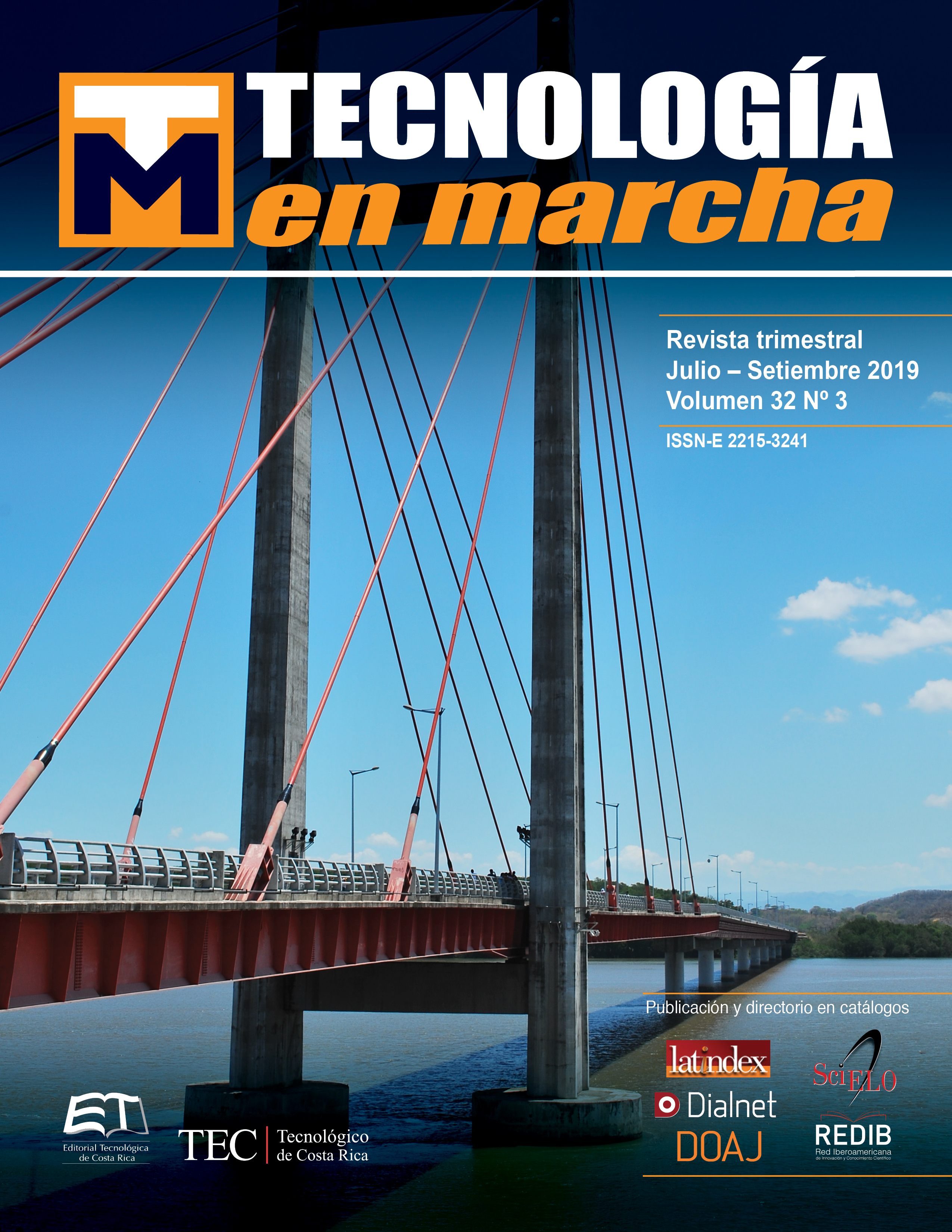Comparison of global and local optimization methods for the calibration and sensitivity analysis of a conceptual hydrological model
Main Article Content
Abstract
Eight global and eight local optimization methods were used to calibrate the HBV-TEC hydrological model on the upper Toro river catchment in Costa Rica for four different calibration periods (4, 8, 12 and 16 years). To evaluate their sensitivity to getting trapped in local minima, each method was tested against 50 sets of randomly-generated initial model parameters. All methods were then evaluated in terms of optimization performance and computational cost. Results show a comparable performance among various global and local methods as they highly correlate to one another. Nonetheless, local methods are in general more sensitive to getting trapped in local minima, irrespective of the duration of the calibration period. Performance of the various methods seems to be independent to the total number of model calls, which may vary several orders of magnitude depending on the selected optimization method. The selection of an optimization method is largely influenced by its efficiency and the available computational resources regardless of global or local class.
Article Details
Los autores conservan los derechos de autor y ceden a la revista el derecho de la primera publicación y pueda editarlo, reproducirlo, distribuirlo, exhibirlo y comunicarlo en el país y en el extranjero mediante medios impresos y electrónicos. Asimismo, asumen el compromiso sobre cualquier litigio o reclamación relacionada con derechos de propiedad intelectual, exonerando de responsabilidad a la Editorial Tecnológica de Costa Rica. Además, se establece que los autores pueden realizar otros acuerdos contractuales independientes y adicionales para la distribución no exclusiva de la versión del artículo publicado en esta revista (p. ej., incluirlo en un repositorio institucional o publicarlo en un libro) siempre que indiquen claramente que el trabajo se publicó por primera vez en esta revista.
References
[2] Madsen, H., Wilson, G., Ammentorp, H.C., 2002. “Comparison of different automatic strategies for calibration of rainfall-runoff models”. J. Hydrol. 261, 48-59.
[3] Beven, K.J., 1993. “How far can we go in distributed hydrological modelling?” Hydrol. Earth Syst. Sci. 5, 1-12.
[4] Gramacy, R.B., Gray, G.A., Le Digabel, S., Lee, H.K.H., Ranjan, P., Wells, G. & Wild, S.M. 2015. “Rejoinder: Modeling an Augmented Lagrangian for Blackbox Constrained Optimization”. Technometrics. 58, 26-29.
[5] Gupta, H.V., Sorooshian, S., Yapo, P.O., 1998. “Toward improved calibration of hydrological models: multiple and noncommensurable measures of information”. Water Resour. Res. 34 (4), 751-763.
[6] Cheng, Y., Liang, F., 2016. Comment: “Modeling an Augmented Lagrangian for Blackbox Constrained Optimization” by Gramacy et.al. Technometrics. 58(1), 15-17.
[7] Jeon, J.H., Park, C.G., Engel, B., 2014. “Comparison of performance between Genetic Algorithm and SCE-UA for calibration of SCS-CN surface runoff simulation”. Water. 6 (11), 3433-3456.
[8] Arsenault, R., Poulin, A., Côté, P., Brissette, F., 2014. “Comparison of Stochastic Optimization Algorithms in Hydrological Model Calibration”. J. Hydrol. Eng. 19 (7). 1374-1384.
[9] Piotrowski, A.P., Napiorkowski, M.J., Napiorkowski, J.J., Osuch, M., Kundzewicz, Z.W., 2017. “Are modern metaheuristics successful in calibrating simple conceptual rainfall–runoff models?” Hydrol. Sci. J. 62 (4), 606-625.
[10] Mendez, M., Calvo-Valverde, L., 2016. “Development of the HBV Hydrological Model”. Procedia Eng. 154, 1116-1123.
[11] Lindström, G., Johansson, B., Persson, M., Gardelin, M., Bergström, S., 1997. “Development and test of the distributed HBV-96 hydrological model”. J. Hydrol. 201, 272-288.
[12] R Core Team. 2018. “R: A language and environment for statistical computing. R Foundation for Statistical Computing”. Vienna, Austria. URL https://www.R-project.org/.
[13] Booij, M.J., 2005. “Impact of climate change on river flooding assessed with different spatial model resolutions”. J Hydrol. 303, 176-198
[14] Kobold, M., Brilly, M., 2006. “The use of HBV model for flash flood forecasting”. Nat.Hazards Earth Syst.Sci. 6, 407-417.
[15] Wale, A., Rientjes, T.H.M., Gieske, A.S.M., Getachew, H.A., 2009. “Ungauged catchment contributions to Lake Tana’s water balance”. Hydrol. Process. 23, 3682-3693.
[16] Seibert, J., Vis, M.J.P., 2012. “Teaching hydrological modeling with a user-friendly catchment-runoff-model software package”. Hydrol. Earth Syst. Sci. 16, 3315-3325.
[17] Nelder, J.A., Mead, R., 1965. “A simplex algorithm for function minimization”. Comput. J. 7, 308-313.
[18] Broyden, C.G., 1965. “Quasi-Newton methods and their application to function minimization”. Math. Comput. 21, 368-381.
[19] Hooke, R., Jeeves, T.A., 1961. “ Direct search solutions of numerical and statistical problems”. J. ACM. 8, 212-229.
[20] Nash, J.C., 1979. “Compact Numerical Methods for Computers: Linear Algebra and Function Minimisation”. Adam Hilger, Bristol. Second Edition. Bristol: Institute of Physics Publications.
[21] Powell, M.J.D., 2009. “The BOBYQA algorithm for bound constrained optimization without derivatives”. Report No. DAMTP 2009/NA06, Centre for Mathematical Sciences, University of Cambridge, UK.
[22] Birgin, E.G., Martinez. J.M., Raydan, M., 2001. “SPG: software for convex-constrained optimization”. ACM T. Math. Soft. 27 (3), 340-349.
[23] Fox, P.A., Hall, A.D., Schryer, N.L., 1978. “The PORT Mathematical Subroutine Library”. ACM T. Math. Soft. 4, 104-126.
[24] Moré, J.J., 1978. “The Levenberg-Marquardt algorithm: implementation and theory”. Lecture Notes in Mathematics 630: Numerical Analysis, G.A. Watson (Ed.), Springer-Verlag: Berlin.
[25] Kirkpatrick, S., Gelatt, C.D., Vecchi, M.P., 1983. “Optimization by Simulated Annealing”. Science, 220, 671-680.
[26] Storn, R., Price, K., 1997. “Differential Evolution - A Simple and Efficient Heuristic for Global Optimization over Continuous Spaces”. J. Global. Optim. 11 (4), 341-359.
[27] Wang, Q.J., 1991. “The genetic algorithm and its application to calibrating conceptual rainfall-runoff models”. Water Resour. Res. 27, 2467-2471.
[28] Duan, Q., Sorooshian, S., Gupta, V.K., 1994. “Optimal use of the SCE-UA global optimization method for calibrating watershed models”. J. Hydrol. 518, 265-284.
[29] Kennedy, J., Eberhart, R., 1995. “Particle Swarm Optimization”. in proceedings IEEE international conference on Neural networks, 1942-1948.
[30] Gablonsky, J.M., Kelley, C.T., 2001. “A locally-biased form of the DIRECT algorithm”. J Global. Optim. 21 (1), 27-37.
[31] Kaelo, P., Ali, M.M., 2006. “Some variants of the controlled random search algorithm for global optimization”. J .Optim. Theory. Appl. 130 (2), 253-264.
[32] Birgin, E.G. & Martinez, J.M. 2008. “Improving ultimate convergence of an augmented Lagrangian method”. Optim. Method. Softw. 23 (2), 177-195.
[33] Husson, F., Le, S., Pages, J., 2010. “Exploratory Multivariate Analysis by Example Using R”. Chapman and Hall. New York.

